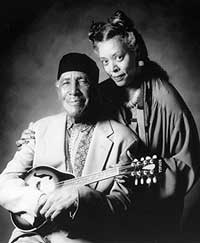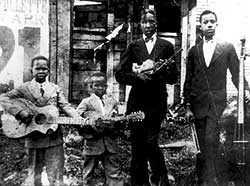|
|
 |
|
|
|
Sweet Old Song
How rare it is for the same person, however extraordinary, to become the subject of two documentaries made some 20 years apart. And how remarkable to see that their subject, Howard Armstrong, changed so little in the years between his 70s and his 90s. As I wrote in my 1985 review of "Louie Bluie," I came to love the music and the spirit of Armstrong on those Monday nights in the 1970s when Martin, Bogan and the Armstrongs performed at the Earl of Old Town in Chicago. I was fascinated by Armstrong: What exactly was he up to? He was a consummate musician, a satirist, a kidder, a clown, a man whose affection for his music and his fellow musicians enveloped every performance. He was a man above all of infinite curiosity, who had somehow survived the cruel conditions of racism in his youth by simply forging ahead with what he loved to do, and allowing its joy to feed his spirit. It was not until "Louie Bluie" that I learned Armstrong also painted and drew, and not until "Sweet Old Song" that I learned what a remarkable, original artist he was. One of the gifts of the second film is the way it shows him recreating the life and family of his wife, Barbara Ward, through his drawings and paintings of her memories. |
 |
|
We learn in the film that when Barbara and Howard first met, neither had a good idea of how old the other really was. Not that it mattered. The life force they shared was obviously the whole point. Although Armstrong seemed ageless, time has a way of passing, and it was a blessing that through Barbara he was able to continue his art and music, his traveling and storytelling, and especially his teaching, during years when he might have been in storage in a retirement home. One of the lessons of the film is that age need not define the length of a career. Graced with health and with art that he loved, Armstrong continued strong until the end, as we see in a remarkable film that shows him visiting festivals and workshops, giving concerts, teaching classes, hailed everywhere as the last of a legendary generation. As ebullient and strong as he was, he could not have continued that way without Barbara Ward, and she is honest and moving in the way she talks about her worries and concerns, her questions about a man of his age living such an active life. |
||
|
|
I first heard about "Sweet Old Song" from my wife, Chaz, who said she had seen a PBS documentary about an old African-American musician who was so incredible I should show the film at the Overlooked. When she told me his name was Howard Armstrong, I shouted: Howard Armstrong! I know exactly who he is! I told her the story of the Earl of Old Town, and I was astonished to discover he was still alive and active 30 years after I first heard him. I knew of course that "Sweet Old Song" should be preceded by "Louie Bluie," so the audience could appreciate the persistence of his life force over the years. We hoped of course to have Howard and Barbara with us on the stage of the Virginia, but in the summer of 2003 I opened up the New York Times and learned that he had died. We are so pleased that Barbara Ward and other musicians who worked with Howard will join us to play some of the music he made and loved. |
|
|
|
The Times obituary did such a good job of placing the importance of Armstrong's life and music that we reprint it below. * * * August 2, 2003, Saturday Howard Armstrong, 94, String-Band Fiddler and Mandolinist By JON PARELES Howard Armstrong, the last guardian of a vanishing African-American tradition of string-band music, died on Wednesday in Boston, where he lived. He was 94. Mr. Armstrong played 22 instruments although he was best known as a fiddle and mandolin player. He performed with a virtuoso's panache, pleasing audiences with fast fingers and a droll stage presence. His repertory included blues, standards, country tunes, rags, work songs, jigs, reels, polkas, spirituals, Hawaiian songs and international songs in the seven languages he spoke. His gifts as a musician and raconteur were captured in a 1985 documentary by Terry Zwigoff called ''Louie Bluie,'' a nickname that Mr. Armstrong got from a drunken fan in the 1930's. A documentary by Leah Mahan, ''Sweet Old Song,'' was broadcast last year on PBS, and will be shown again on Aug. 12. William Howard Taft Armstrong was born in 1909 in Dayton, Tenn., and grew up in LaFollette, Tenn. He was one of nine children whose father, Thomas Armstrong, was a factory worker and a musician who led the elder children in a family band. When Thomas Armstrong became a preacher, he renounced music and gave his mandolin to Howard, warning that it was a ''devil's instrument.'' Howard had already made his own fiddle out of a box strung with horsehair. Later he organized his younger brothers into the Armstrong Brothers Band. As a teenager, Mr. Armstrong joined the band led by a blind fiddler in Knoxville, Roland Martin, soaking up his style. He learned to read music, a skill that he called ''knocking blackbirds off the fence.'' He also studied art at Tennessee State Normal School in Nashville, later supported himself at times as a sign painter and a mural painter. He also made autobiographical paintings throughout his life. African-American string bands were widespread across the South in the 19th and early 20th centuries, performing at parties, medicine shows, saloons and fish fries. Tunes and techniques moved freely between white and black string bands. Mr. Armstrong joined Roland Martin's stepbrother, the guitarist Carl Martin, and a mandolinist, Ted Bogan, and began performing around the South, sometimes with Roland Armstrong, Howard's brother, on bass. After performing on the radio in Knoxville, Mr. Armstrong's group made its first recordings there in 1930 as the Tennessee Chocolate Drops but worked under various names, including the Four Aces. Their recordings are among the few African-American string band sides recorded by companies that classed ''hillbilly'' music as white, and favored blues, jazz and gospel ''race records'' for African-Americans. Martin, Bogan and Mr. Armstrong spent the Great Depression years working their way through southern Appalachia and the Midwest. They wound up in Chicago, playing on street corners until Mr. Armstrong had the idea of what he called ''pulling doors'': boldly stepping into saloons in immigrant neighborhoods and winning over Poles or Irishmen or Italians or Germans with old songs in their own languages, many of which Mr. Armstrong had learned from neighbors as a child. They also appeared at the 1933 Chicago World's Fair and recorded with the blues singers Big Bill Broonzy and Bumble Bee Slim. During World War II Mr. Armstrong worked for the civil service as a sign painter and was working at Pearl Harbor when it was attacked in 1941. His music went out of style after the war, and from 1944 to 1971 he worked on the Chrysler assembly line in Detroit. But in the 1970's that music was rediscovered, his music career revived and he reunited with Martin and Bogan. They played a weekly club date at the Earl of Old Town bar in Chicago, made albums, including ''Barnyard Dance'' (Rounder) in 1972 and ''That Old Gang of Mine'' (Flying Fish) in 1978, and appeared on Steve Goodman's 1975 album ''Jessie's Jig and Other Favorites'' (Red Pajamas). They also began touring, playing at coffeehouses, folk festivals and on a State Department tour of Central and South America. In 1990 Mr. Armstrong received a National Heritage Fellowship award from the National Endowment for the Arts. Mr. Armstrong released a solo album, ''Louie Bluie'' (Blue Suit), in 1995, and it won a W. C. Handy award from the Blues Foundation. He continued to perform and record until early this year. During the 1980's he met Barbara Ward, and the couple moved to her hometown, Boston, in 1996. She became the manager and drummer for his band, and they were married in 2001. They collaborated on projects, including an illustrated children's book. She survives him along with his sons, Ralphe, Will and Robert Armstrong; 13 grandchildren; and 2 great-grandchildren. Copyright 2003 The New York Times Company |
|

